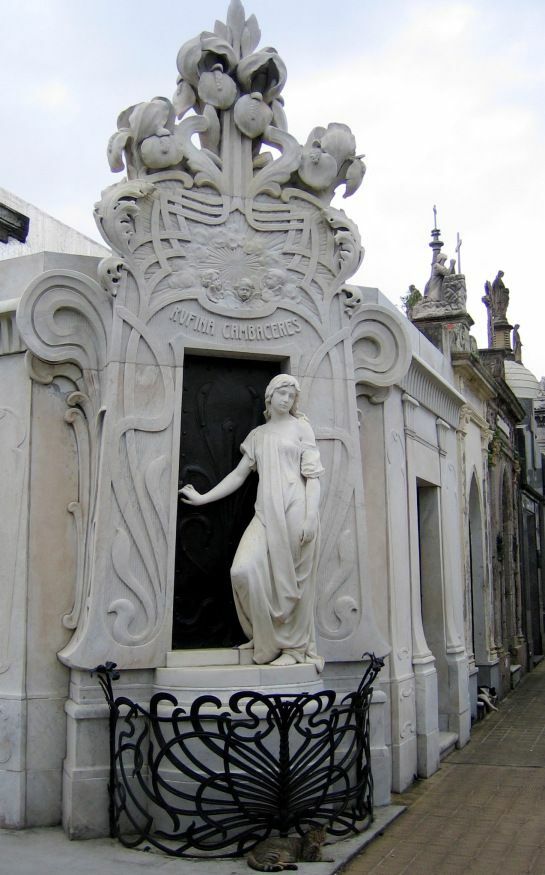The girl who died twice: when dying once is not enough.
Once upon a time, there was a young woman who was as beautiful as it was unfortunate since death would not reach her once but twice. The legends say that her soul is condemned to wander the alleys of the Recoleta cemetery in the city of Buenos Aires to this day, telling between sobs her own story to those who are lucky (or not). Her name was Rufina Cambaceres, and she was the most beautiful girl of her time.
The Cambaceres were part of the Argentinian aristocracy during the 19th century. Though cultured, intelligent, and wealthy, they fall in disgrace due to a terrible reputation. In 1876, Eugenio Cambaceres started a torrid romance with Emma Wizjiak, soprano at the Teatro Colón. But there was a tiny little detail: Emma was a married woman who enjoyed playing with fire too much, cause one day her jealous husband discovered the affair and challenged Eugenio to a duel that never took place, and the jilted husband eventually ended up leaving the country, and of course, Emma too. Until then, Cambaceres had what is known as a promising future in politics, but the scandalous affair came with social shaming and took him away from that area. So, the always curious Eugenio decided to take a turn in his career. He devoted his life to literature, though with no luck or success, the truth is that Cambaceres registered like few others the problems that the immigration waves were generating in the country and the congenital defects of the Argentine bourgeoisie. Something that would never be forgiven. Furthermore, years later, he added the third scandal to his life by falling in love with Luisa Bacichi, an Italian dancer, which for the time meant being more or less an undercover prostitute. It was the straw that broke the camel's back for Buenos Aires society to plunge Eugenio into the worst of discredit. They married in 1887, and in 1888 they had a daughter. They gave her the same name as her great-grandmother: Rufina. Eugenio died shortly after.
Rufina grew up in an aristocratic environment, surrounded by girls of her age doing what every good young woman should do for that time: long walks with friends, reading poetry, embroidery task and gossiping in whispers about society. Soon Rufina's beauty started to be noted by everyone, and as in a fairy tale, this fresh and young beauty started competing with her own mother, who unwisely listened to the voices in her mirror, cause no longer Luisa was the most beautiful woman in the realm.
After Eugenios Cambaceres's death, the family maintained a traditional social behaviour: they held intimate parties and feasts. One of the most fervent attendees was a tall, intelligent, elegant, thick-voiced man who years later would be one of the most essential Argentine presidents. Rufina was younger when she met him and fell in love with him, who was already in his 50s, but at that time, that difference was acceptable, even advisable. There was between them, then, one of those platonic romances made of small significant gestures: typical of a Victorian novel: shy glances, mischievous smiles, discreet hand roses, and a rising tension that seemed to have no relief. One night, he invited her to the opera. The tragedy was around the corner.
And this is where our legend begins.
Rufina was excited about her lover's invitation. She thought that that night, after the opera at the Colon Theater, they would consummate the love that until that moment remained as only suggestions. A friend came to visit her that morning, and they discussed the matter. Her friend had to say something to her, something that consumed the entire space of her heart, but she did not dare, but in the end, she decided it was better to tell the truth, and spare Rufina for a humiliation worse than the one she was already suffering from. She confessed what she knew, what everyone knew, except Rufina, of course. Her love interest was the secret lover of her mother, Luisa. Rufina told her friend that she was not feeling well, that she had to rest for a second in her room, and that she had to be left alone. With all the pain in her heart and soul, Rufina went upstairs and did not come down again.
Two hours later, Rufina's maid found her in her bed. From the unnatural position of her body, she did not seem asleep. She tried to wake her up: she spoke to her, took her by the shoulder, shook her, and Rufina did not get up. An hour later, the family doctor came to the house. Just seeing her, touching the coldness of her skin, he understood what was happening. However, he examined Rufina to be sure and did not find her pulse. Despite her young age, Rufina had died of syncope. Literally, she had broken her heart.
That same night Rufina was buried in the Cambaceres family pantheon. According to the traditions, she was buried with the jewels that had belonged to her during her lifetime. Her heartbroken mother fell over her body before the coffin lid was nailed down. Luisa screamed and screamed that her daughter wasn't dead, that she couldn't be dead. Between relatives and friends, they had to hold the woman by her arms, carry her away and reassure her that Rufina was now resting in peace.
During the XIX Century, the role of the guardians and undertakers in the cemeteries included the protection of the vaults. It was very often that looters and thieves tried to get hold of the jewels and belongings of the deceased. But it was the guardian of that terrible night who took the fright out of his life. During the early hours of the dawn and still a bit dark, while he was walking through the area of the Cambaceres family pantheon, he heard noises. Deep and bass noises. He feared the worst: that thieves had entered the pantheon, that they would have taken the jewels of poor Rufina, dead in the prime of age. The following day, Luisa and a friend went to the cemetery. Accompanied by the guardian, they opened the old creaking door of the pantheon. The first thing they discovered was that the coffin was shaken.
The men came in and pried it open. They discovered that the top of the coffin was scratched on the inside and that Rufina's body had turned over: she was lying face down. The third thing they discovered was that the jewels were still there; the fourth, the scratches. Rufina's face, neck, and chest were scratched. Under her fingernails, remains of the wood from the coffin lid. Then they began to understand. Rufina had woken up some time that night. In the dark, hearing the sound of her breathing, still calm, streaking from the memory of that morning, the ghastly revelation of her friend, her subsequent swoon. Rufina reached out her hands and touched her own coffin's inner plush. She screamed until her voice was torn. She hit her wooden prison over and over again. What follows is not advisable even to imagine. The truth is that she died, she died again, that night, of suffocation.
This urban legend remains in force to this day. Visitors from all over the world come to the Recoleta Cemetery to visit the pantheon of the Cambaceres family to admire the beautiful sculpture dedicated to Rufina Cambaceres that opens the door of her own every night vault to breathe the fresh air once more.
If you like this story and came to Buenos Aires, be sure to visit it. Below you will find information about the cemetery and the visits it offers, as more than one story can be found there.
Feel free to comment, ask, donate and collaborate with this humble journalist who loves research. More stories coming soon.
https://turismo.buenosaires.gob.ar/es/otros-establecimientos/cementerio-de-la-recoleta
